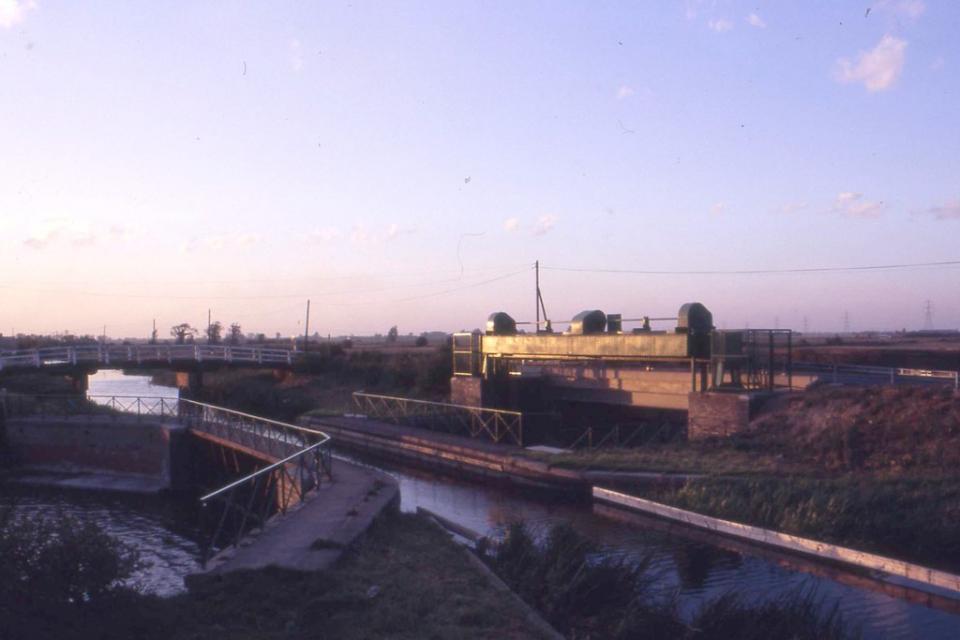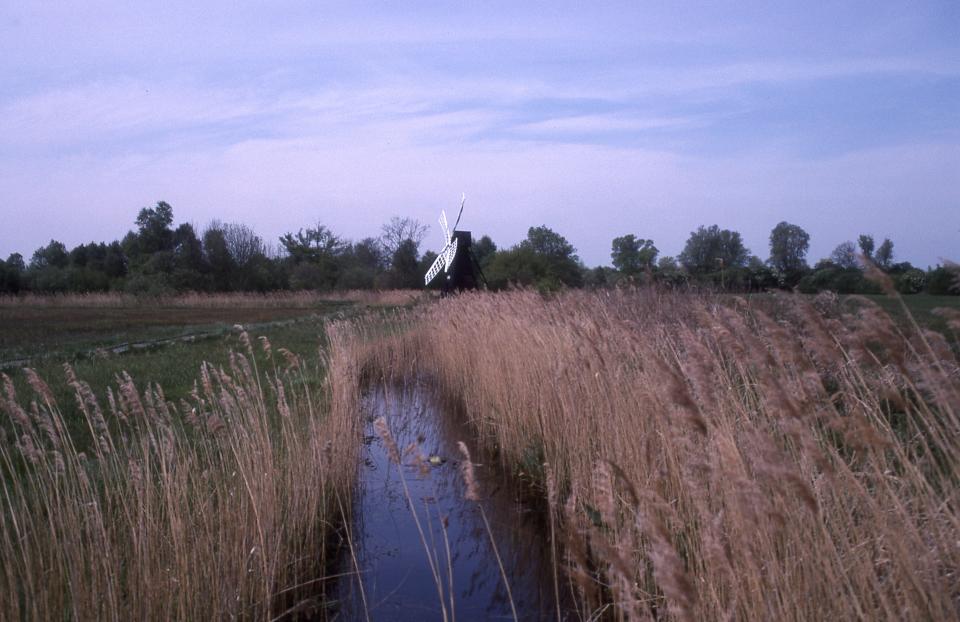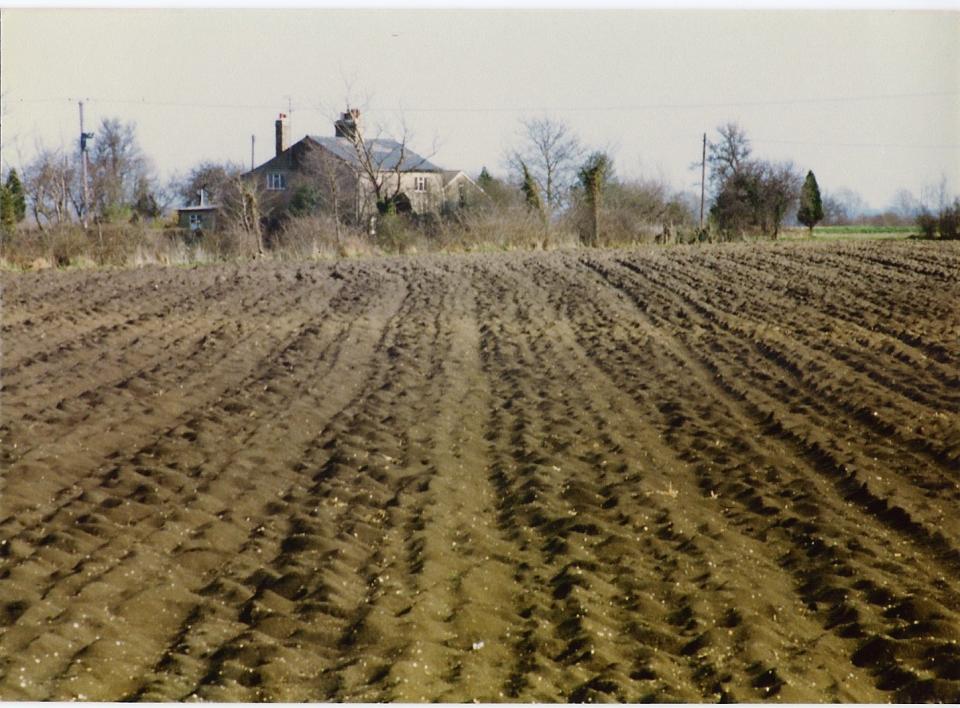At the end of the sixteenth century, East Anglia was a fluctuating expanse of tidal wash, saltmarsh, and seasonally-submerged fens. Today, only one percent of this wetland remains. Transformed into peat-rich arable land by large-scale drainage that accelerated rapidly at the turn of the seventeenth century, the environmental history of the fens is marked by the emergence of industrial capitalism and the erasure of a littoral ecosystem. For Richard Irvine, this intersection of extractive geoengineering, exacerbated flood risk, and carbon emissions from peat wastage has shaped an environment “in which the characteristics of the Anthropocene epoch are acutely visible.”

Aqueducts and pumping stations form a latticework of drainage infrastructure in the fens, 1993.
Aqueducts and pumping stations form a latticework of drainage infrastructure in the fens, 1993.
Photo by Sludge G, 2009, on Flickr. Click here to view the source.
 This work is licensed under a Creative Commons Attribution-ShareAlike 2.0 Generic License.
This work is licensed under a Creative Commons Attribution-ShareAlike 2.0 Generic License.
Composed by the Marxist-feminist poet Wendy Mulford over a decade of fieldwork and archival research inspired by the “open-field” poetry of the 1970s, The East Anglia Sequence navigates these radical shifts in socioecological relations at the close of the sixteenth century. Assembling a shifting archive of found text fragments ranging from parish records to meteorological data, Mulford’s collection captures the fluctuations of this littoral field through the methodological juxtaposition of environmental history and historical materialism. For Mulford, open-field poetics manifests as an interdisciplinary mode of inquiry “located in the meteorology, archaeology, geology, ecology, ornithology, prehistory,” as much as “the recorded history of place.”

Coastal erosion in Suffolk, UK.
Coastal erosion in Suffolk, UK.
Photo by Pete Chapman, 2002. Accessed via Wikimedia Commons.
 This work is licensed under a Creative Commons Attribution-ShareAlike 2.0 Generic License.
This work is licensed under a Creative Commons Attribution-ShareAlike 2.0 Generic License.
Traversing these archival and stratigraphic records, The East Anglia Sequence interrogates infrastructures of drainage and legal architectures of flood risk from the Fen Codes of 1549 to the organized abandonment of coastal communities in the 1980s. Gesturing to the “all-but-buried” pasts excluded from official archives, Mulford’s preface situates this historical methodology against a Marxist-feminist project of salvaging the “hidden half of history.” If what remains of the fens is the geophysical imprint of geoengineering, the collection offers a counter-history of drainage that tracks the displacement of social reproduction from the commons and the erasure of this feminized labor from the written record, excavating the illegible “substratum” that Amy De’Ath has called “the hidden abode of reproduction.”

A drainage ditch and wind-powered pumping station, East Anglia, n.d.
A drainage ditch and wind-powered pumping station, East Anglia, n.d.
Unknown photographer. Accessed via Piqsels.
 This work is licensed under a Creative Commons Public Domain Mark 1.0 License.
This work is licensed under a Creative Commons Public Domain Mark 1.0 License.
If East Anglia’s latticework of dykes and sea defences appears as the material inscription of industrialization, the Anthropocenic account offered by Irvine’s “carbon history” of the fens nonetheless elides the sixteenth-century enclosures that made labor-intensive land reclamation a profitable investment for early venture capitalists. Tracing the process of expropriation subtending industrial improvement, Joan Thirsk has demonstrated how the drainage of tidal marshes for peat-rich soil depended on the valuation of these “unimproved commons” as a “profitless waste.” For the inhabitants of the fens, however, this “extensive commons was essential to life.”
While resistance ranged from sabotaged dykes to open revolt, The East Anglia Sequence records the case of an unnamed commoner who renders her losses legible in parish records by occupying the local church in 1590, a few years prior to the onset of large-scale enclosure and reclamation. Articulating the interlocking social and environmental costs of drainage, Mulford indexes the lost biodiversity of the fens:
gathered up her family into
Kett’s Rebellion of 1549, Norfolk. Engraving by Samuel Wale, 1785.
Kett’s Rebellion of 1549, Norfolk. Engraving by Samuel Wale, 1785.
Accessed via Wikimedia Commons.
This work is licensed under a Creative Commons Public Domain Mark 1.0 License.
St Nicholas porch they
did not budge stir disturb move
from one’s place 1590 the
land lord
compelled to rehouse them she
challenged his & nature’s expropriation
listing her grievances viz.
loss of eels
loss of fish
samphire
grazing
flags furzes
whins from heath
wildfowl plants marshland
herbs
loss of food warmth shelter living
Reflecting both the incursions of tidal flooding and landlord’s enclosure of open marshland, this dialectical articulation of “his & nature’s expropriation” frames access to the commons as a struggle over the means of social reproduction. In the same year that The East Anglia Sequence appeared in print, Silvia Federici had published her seminal account of enclosure enabling “the appropriation and concealment of women’s labor” as processes external to value-producing work. Following the loss of collective subsistence and gleaning rights afforded by the common, Federici argued, reproductive labor was confined and reorganized around the domestic sphere. As Mulford has it, the history of enclosure is also “the history of the family.”

Tilled peat fields in the fens, n.d.
Tilled peat fields in the fens, n.d.
Photo by Graham Knott on Flickr. Click here to view the source.
 This work is licensed under a Creative Commons Attribution-NonCommercial 2.0 Generic License.
This work is licensed under a Creative Commons Attribution-NonCommercial 2.0 Generic License.
Rendered external to the wage and the wetland common, the labor of social reproduction was subject to the same process of devaluation as these partially submerged “wastes.” Where Mulford frames the “scouring” and “succouring” of domestic maintenance against the “huswifely scavenging” of alluvial deposition in the tidal marsh, this suggestive metonymy encapsulates the simultaneous expropriation of reproductive work and reclaimed wetland. As Maria Mies articulated in 1986, feminized labor and communal lands were “transformed into a vast reservoir of material resources to be exploited and turned into profit.” For Mulford, as for Mies, this gendered division of labor remained acutely relevant to contemporary struggles against the welfare cuts and new enclosures of Thatcherite neoliberalism.
Since the 1980s, Marxist-feminists have insisted that the ongoing enclosure and expropriation of reproductive work remains equally pivotal to historical materialism and environmental history. Reiterating this claim, Françoise Vergès and Stefania Barca each highlight the elisions that mark Anthropocenic narratives of capitalism’s stratigraphic inscription, asking instead what the “geology of mankind” might look like from the counter-hegemonic perspective of subsistence work, waste metabolism, and social reproduction. Echoing the scavenging of the sea through its dispersal and retrieval of archival materials, The East Anglia Sequence reworks the salvage rhythms of the wetlands toward a poetic methodology for scouring, gleaning, and uncovering hidden histories among the strata. Framed against these trajectories in Marxist-feminist inquiry, Mulford’s work continues to unsettle sedimented narratives of East Anglia’s history and its enduring significance to the Anthropocene present.
PRIMARY SOURCES
- Mulford, Wendy. The East Anglia Sequence: Norfolk 1984–Suffolk 1994. Peterborough: Spectacular Diseases, 1998.
How to cite
Carter, Fred. “‘his & nature’s expropriation’: Wetland Enclosure, Salvage Poetics, and Social Reproduction in Wendy Mulford’s East Anglia Sequence.” Environment & Society Portal, Arcadia (Autumn 2022), no. 18. Rachel Carson Center for Environment and Society. doi:10.5282/rcc/9542.
ISSN 2199-3408
Environment & Society Portal, Arcadia
 This work is licensed under a Creative Commons Attribution 4.0 International License.
This work is licensed under a Creative Commons Attribution 4.0 International License.
2022 Fred Carter
This refers only to the text and does not include any image rights.
Please click on an image to view its individual rights status.
- Barca, Stefania. Forces of Reproduction: Notes for a Counter-Hegemonic Anthropocene. Elements in Environmental Humanities, edited by Louise Westling, Serenella Iovino, and Timo Maran. Cambridge: Cambridge University Press, 2020.
- De’Ath, Amy. “Hidden Abodes and Inner Bonds: Literary Study and Marxist-Feminism.” In After Marx: Literature and Value in the Twenty-First Century, edited by Colleen Lye and Christopher Nealon, 225–39. Cambridge: Cambridge University Press, 2022. doi:10.1017/9781108776523.015.
- Irvine, Richard. “Anthropocene East Anglia.” The Sociological Review 65, no. 1 (2017): 154–70. doi:10.1177/0081176917693745.
- Mies, Maria. Patriarchy and Accumulation on a World Scale: Women in the International Division of Labour. London: Zed Books, 1986.
- Mulford, Wendy. “Socialist-Feminist Criticism: A Case Study, Women’s Suffrage and Literature, 1906-14.” In Re-Reading English, edited by Peter Widdowson, 179–92. London: Methuen & Co. Ltd, 1982.
- Thirsk, Joan. English Peasant Farming: The Agrarian History of Lincolnshire from Tudor to Recent Times. London: Routledge & Kegan Paul, 1957.
- Vergès, Françoise. “Capitalocene, Waste, Race, and Gender.” E-Flux 100 (2019), https://www.e-flux.com/journal/100/269165/capitalocene-waste-race-and-gender/.










